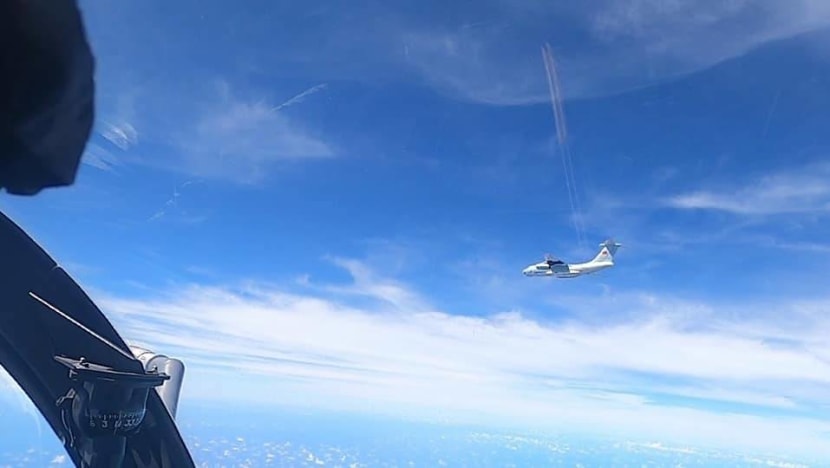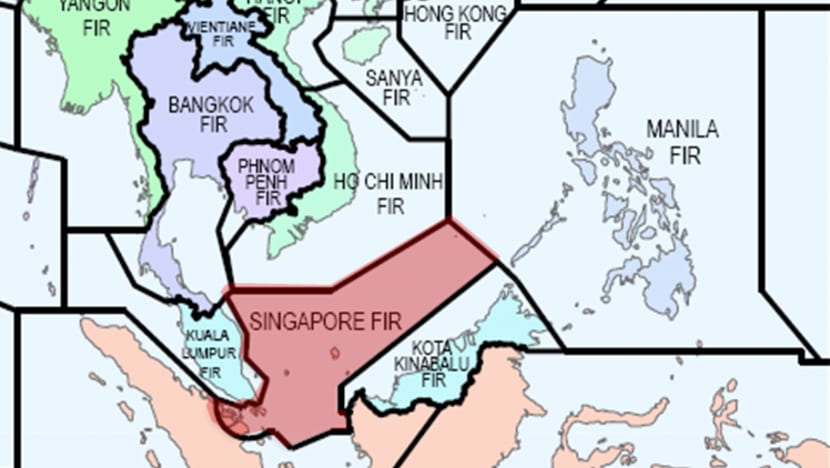Chinese military jets that crossed into Singapore FIR on May 31 'not deemed a threat': Ng Eng Hen

Photo of the Luyshin LL-76 intercepted by RMAF aircraft. (Photo: Facebook/ Tentera Udara Diraja Malaysia)
SINGAPORE: The May 31 incident involving Chinese military jets crossing unannounced into the Singapore Flight Information Region (FIR) was not deemed to be a threat to Singapore, Defence Minister Ng Eng Hen said on Tuesday (Jul 6).
Dr Ng was responding to a question by Member of Parliament (MP) Dennis Tan (WP-Hougang), who asked for the Government's situational assessment after 16 People’s Liberation Army Air Force (PLAAF) aircraft passed through Singapore’s FIR over waters disputed by China and Malaysia.
Malaysia's air force had said a day after the incident that the Chinese planes flew via Singapore FIR before entering the Malaysia maritime zone air space and the Kota Kinabalu FIR.
MP Gerald Giam (WP-Aljunied) also asked how many of such unannounced entries into Singapore's FIR by PLAAF aircraft had occurred over the past year.
"Singapore is a small country with a high population density, and therefore more vulnerable to air threats. The Singapore Armed Forces accordingly maintains air defence units at high alert," said Dr Ng.
"The Republic of Singapore Air Force (RSAF) conducts 24/7 surveillance of our skies through both ground-based radars and aerial reconnaissance to detect unknown or suspicious aircraft that are close enough to pose a potential threat."
The RSAF responds to an average of more than 350 such incidents each year, he said.
"The specific incident referred to by the two Members in their questions were not deemed to be such a threat," he added.
READ: Malaysian air force scrambles hawk jets after Chinese military planes detected near its national airspace

An FIR is a specific region of airspace in which an air traffic services authority appointed by the International Civil Aviation Organization (ICAO) provides and manages flight information and alerting services.
The current Singapore FIR, managed by the Civil Aviation Authority of Singapore (CAAS), includes Singapore's national airspace as well as airspace over parts of Indonesia and the South China Sea.
Dr Ng said CAAS' role in within the Singapore FIR is to ensure safe and efficient flow of air traffic, mostly civilian.
An air traffic services authority does not act as a watchdog over disputed areas nor should it adopt a partisan role on behalf of any party or for itself, he added.
READ: Commentary: The trickiness of dealing with stray aircraft when territorial lines are grey
CHINESE AIRCRAFT NOT REQUIRED TO CONTACT CAAS
While Dr Ng said civilian aircraft must file a flight plan with CAAS when going through Singapore FIR, state aircraft - which includes military aircraft - are not required to do so under international law.
"State aircraft are also not obliged to contact the air traffic services authority, so long as they fly with due regard for the safety of the aircraft," he said.
Still, some militaries such as the RSAF file flight plans and contact the air traffic services authority of an FIR they are entering. The RSAF does so to help the authority coordinate and deconflict RSAF flights from civilian aircraft, Dr Ng said.
However, Dr Ng said many state aircraft from many countries typically do not file flight plans or contact the air traffic services authority.
Dr Ng said CAAS did not receive a flight plan from the PLAAF jets, and did not communicate with the Chinese air force or any of its aircraft.
"Nevertheless, had the PLAAF required air traffic services, it could have established communications with CAAS," he said.
"We should be clear that the RSAF has no mandate nor any role in the management of the Singapore FIR."
READ: Commentary: Can the Malaysian air force handle more airspace incursions by Chinese planes?
ENSURING MILITARY AIRCRAFT DO NOT HAVE HOSTILE INTENT
Mr Giam then asked how Singapore can ensure that state aircraft entering Singapore FIR do not have hostile intent.
In detecting hostile aircraft, said Dr Ng, the RSAF looks at various aspects such as their movement and whether they have filed flight plans.
Pointing to the 350 incidents that the RSAF responds to each year, Dr Ng added that the RSAF has had to use its judgment according to strict protocols in some of those instances.
"Let me again emphasise these 350 incidents has got nothing to do with questions that the two Members have asked," he added.
"Because they have framed their questions in a way that can actually give rise to misunderstanding and misinterpretations."
RIGHT OF PASSAGE FOR MILITARY AIRCRAFT AND SHIPS
Ultimately, said Dr Ng, Singapore respects the right of military aircraft and ships to conduct passage and training over areas and waters in accordance with international law.
"This is the basis upon which the Republic of Singapore Air Force aircraft conduct flights and training, whether it's in the South China Sea or other regions," he said.
"This is also the basis for the conduct of exercise in the South China Sea - the ones that Singapore does bilaterally and in multilateral exercise."












